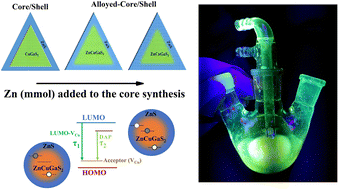Zn alloying strategy to improve the photoluminescence of CuGaS2/ZnS core/shell quantum dots†
Abstract
Research efforts are being devoted to realize colloidal, heavy metal ion free, and luminescent quantum dots. We address radiative recombination in Zn alloyed CuGaS2/ZnS core/shell chalcopyrite quantum dots (CQDs) emitting in the blue-green spectral region. QDs show a systematic increase in the optical band gap and emission energy with an increasing amount of Zn in their core. Intentionally making non-stoichiometric CQDs with core/shell geometry enables defect related emission with high intensity. The location of Cu related defect levels along with the valence band and conduction band edge was determined from electrochemical cyclic voltammetry (CV) measurements. The evolution of band gap energies with respect to Zn concentration examined using CV measurements matches well with the optical absorption data. The presence of Cu vacancies in off-stoichiometric samples introduces intra-gap levels, which serve as common acceptor levels for optical transitions. Luminescence transitions in these materials stem from the radiative recombination of electrons from conduction levels as well as donor levels, with holes localized at acceptor levels. Temperature dependent and excitation laser intensity dependent emission measurements confirm the role of the Cu vacancy related acceptor level in the emission. Local structure studies via extended X-ray absorption fine structure and X-ray absorption near edge structure analysis were carried out to understand how Zn is incorporated in CuGaS2 quantum dots and affects the luminescence. Electron spin resonance measurements confirm the presence of paramagnetic defect complexes. X-ray absorption near edge structure measurements indicate that Cu co-exists in +1 and +2 oxidation states in CuGaS2 quantum dots.

- This article is part of the themed collection: 2024 Journal of Materials Chemistry A HOT Papers


 Please wait while we load your content...
Please wait while we load your content...